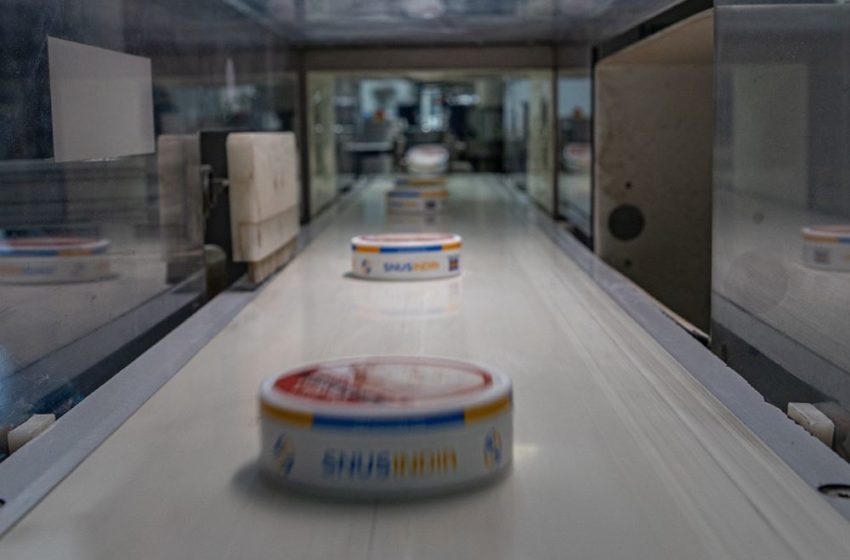Seeking Substitutes
- Also in TR Other Tobacco Products Print Edition Smokeless
- May 1, 2023
- 0
- 11 minutes read

Dholakia Tobacco is offering Indian smokeless tobacco products that are less hazardous than the country’s most commonly used varieties. Photos: Dholakia Tobacco

Modern oral nicotine products could help Indian consumers abandon deadly local smokeless tobacco products.
By Stefanie Rossel
When it comes to tobacco, India holds several records: It is the world’s second-largest consumer, third-largest producer and fifth-largest exporter. Its consumption pattern is also remarkable. According to the 2016–2017 Global Adult Tobacco Survey, 266.8 million adult Indians—28.6 percent of the country’s population—use tobacco in some form.
However, with 199.4 million consumers, the most used tobacco product is smokeless (SLT). Only 99.5 million Indians consume tobacco by smoking it. Of these, only 37.5 million smoke cigarettes. Most smokers prefer bidis—cheap, unfiltered cigarettes made of tobacco flakes wrapped in a tendu or temburni leaf that are even more hazardous to health than factory-made cigarettes.
India has the world’s largest number of SLT users. Unfortunately, the type of SLT that prevails here does not reside on the low end of the risk continuum like other smokeless products such as Swedish snus do. A pasteurized oral tobacco with limited negative health effects, snus has helped Sweden achieve the world’s lowest smoking prevalence. Indian SLTs, by contrasts, are considered “uniquely deadly” by experts.
Indian SLTs come in a large variety. The most commonly used variants are khaini, a mixture of tobacco and lime, and gutkha, which comprises tobacco, slaked lime, paraffin wax as well as catechu, an extract of acacia trees and crushed areca (betel) nut. Other local forms of SLTs contain mixtures of betel quid or paan masala. All are highly addictive and full of carcinogens. In addition to the typical ingredients, they can be laced with thousands of chemicals. Available for a few rupees, these SLTs are affordable for low-income groups. Like bidis, they are predominantly consumed in rural areas, where almost 70 percent of the country’s population lives. SLTs are responsible for an estimated 350,000 premature deaths annually in India.
In line with its national health policy, India aims to reduce the number of tobacco users by 30 percent by 2025. The country closely adheres to the World Health Organization’s abolitionist guidelines, but its tobacco control measures are often contradictory. Attempts to curb tobacco use have remained limited to tax hikes on cigarettes rather than bidis and a ban on e-cigarettes and heated-tobacco products. In 2012, all states banned the manufacture, sale and distribution—but not the public use—of pre-packaged gutkha under laws that defined the product as a food. Some states extended this ban to other oral tobacco products, such as paan masala. Enforcement of these bans has been weak, however.
In an interview with The Free Press Journal, Kiran Melkote of AHER, a harm reduction group, outlined the reasons for India’s ineffective tobacco control policy. “Many arms of the government work at cross purposes and implement policies that even on paper are in direct conflict with the WHO Framework Convention on Tobacco Control. The health ministry tries to implement awareness campaigns and maintain zero industry contact norms for its employees while the commerce ministry provides loans and support for tobacco cultivation and the finance ministry bans e-cigarettes and incentivizes bidi manufacturers. All of them generally ignore oral tobacco. The answer therefore lies in understanding that the strategies used in the developed world where the predominant form of tobacco is the cigarette may not really impact tobacco use in India. Here we have a larger population with different problems and an admitted inability to implement existing laws.”

The success of modern oral products in Pakistan is welcome proof that they can replace the deadlier local oral tobacco.
Potential Solution
Perhaps a look across the border might be useful. India’s neighbor Pakistan has a tobacco consumption profile similar to that of India. An estimated 10 million people use SLT, which represents more than 40 percent of the country’s total tobacco market. Recently, Pakistan has seen a remarkable development: In December, BAT announced that its modern oral nicotine brand Velo had achieved a monthly volume of more than 40 million pouches in the country, making it BAT’s third-largest market for nicotine pouches. Modern oral nicotine products consist of pre-portioned bags comprising nicotine applied to a carrier material. They are considered to be a more advanced, cleaner version of Swedish snus.
Could Pakistan’s experience in substituting hazardous SLT products with less harmful varieties serve as a blueprint for India? “The tobacco use patterns in both nations are similar,” says Samrat Chowdhery, director of the Council for Harm Reduced Alternatives, referring to the high share of oral tobacco use. “Nicotine pouches have not been sold on scale before in the South Asian region, hence their substitution potential for the region’s tobacco users, especially the SLT users, was not known. Their success in Pakistan is welcome proof that they can replace the deadlier local oral tobacco—though whether that is indeed happening needs to be better understood.”
Nihar Dholakia, director of next-generation products at Dholakia Tobacco, an SLT company based in Gujarat, India, has been closely monitoring the rise of the modern oral category in Pakistan. “Given that both Pakistan and India have a similar culture of using SLT products, we believe that the success of nicotine pouches in Pakistan could be replicated in India but on a much larger scale.”
In light of the Indian government’s abolitionist strategy and the competitive structure of the local SLT segment, in which two leading companies jointly hold around 40 percent of the market, less hazardous oral products in India could encounter major hurdles, according to Chowdhery. “Nicotine pouches and snus could face opposition from the SLT lobby unless they can be made to see the business potential,” he says. “It would be a major setback if the government banned safer oral nicotine products too.”
Issues are also likely to come up in terms of cultural heritage and consumer education. “Tobacco use, especially oral, has long been part of India’s cultural milieu, just like alcohol is in western nations,” says Chowdhery. “SLT is also available for cheap, and varieties vary across regions. While the social stigma around smoking is beginning to develop, none exists for oral products as there is no secondary harm. Educating users can be challenging given the number of users, with different cultural norms and languages such that it is difficult to design communications.”
“In India, the avenues available for broadly educating consumers about THR and more specifically finessing that message to SLT users may be very limited,” says Dholakia. “The process seems to be largely organic, with consumers themselves becoming aware of the harmful effects and seeking alternatives. This often involved researching THR and exploring a range of reduced-risk products available. Online resources and word of mouth play a significant role in the education process. However, to make a more substantial impact, we require greater consumer advocacy as well as government initiatives to generally raise awareness.”

We believe that the success of nicotine pouches in Pakistan could be replicated in India---but on a much larger scale.
Treading New Paths
Despite the government’s reluctance to admit safer substitutes, not all is lost for THR in India. Dholakia and other manufacturers are beginning to look at snus and nicotine pouches. With the Paz brand, his business recently launched the first Swedish-style tobacco snus brands in India. “In fact, we operate India’s first online platform for snus,” says Dholakia. “However, we face regulatory challenges, such as the requirements of an 85 percent pictorial warning of product packaging, high taxes and restrictions on advertisement and promotion. Nevertheless, despite these obstacles, we have observed a growing trend among consumers who are actively seeking reduced-risk products as a better alternative.”
Dholakia Tobacco caters primarily to the premium SLT category. “However, considering the fact that India has over 220 million smokeless tobacco users who lack access to harm-reduced alternatives, we aspire to make our products more accessible and available to any SLT user. Therefore, we are determined to expand our reach to a broader audience in the domestic market as well through the right forms of direct-to-consumer education and word-of-mouth product awareness.”
Indian consumers have responded positively to Dholakia’s snus products, particularly after switching from traditional chewing tobacco, cigarettes or khaini. “Many customers have reported experiencing a positive change firsthand, indicating their acceptance and awareness of the harm-reduced properties of snus products,” says Dholakia. “These are some of our future ambassadors for risk-reduced products, who will quite naturally be out there to talk with other consumers about their experiences with these new products.”
The company also manufactures a filtered khaini brand, which has become popular in many Indian states recently. Filtered khaini is a modern version of khaini chewing tobacco that resembles western-style, portion pouch-packed snus but has a significantly different toxicological profile. “Traditional filter khaini available on the market is not less harmful than regular khaini,” clarifies Dholakia. “In fact, it can be thought of as a pulverized moist version of khaini packed in an oral pouch.”
Dholakia’s filtered khaini brand is not the same, he insists. “The filter tobacco products we offer are different in composition when compared to traditional filter khaini and commercially available products in India currently. It can be said it is less harmful than other filter products due to the use of low-impact base ingredients, the type of quality tobacco and the novel processes as well as our advanced approach to product integrity and testing infrastructure. As far as affordability and availability is concerned, these filter products are comparable to regular chewing tobacco and khaini products. They are available in a few states and are perceived by khaini consumers as a more sophisticated version of a mainstay khaini product.”
Dholakia Tobacco has also ventured into modern oral nicotine pouches. It was the first company in India to venture into this category. “As pioneers of modern oral nicotine pouches from India, our products are currently available only in the global markets we cater to and have not yet been launched domestically,” Dholakia says.
“However, we are considering and working toward introducing them in India as we firmly believe that they can have a positive impact on public health in the country. We are confident that Indian consumers are ready for such a product. Accessibility, awareness, the right information, a fair regulatory framework and quality control are key factors that need to be addressed for the category. Given that India is in dire need of multiple harm-reduced products, we are committed to making them available in India.”

